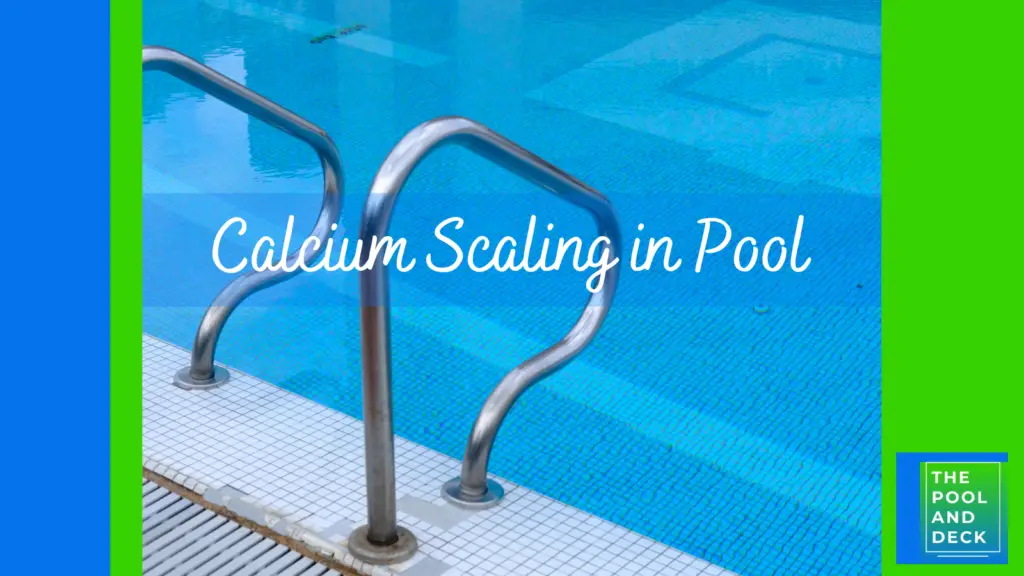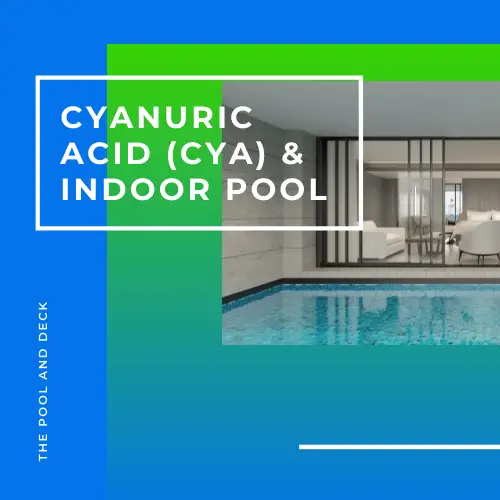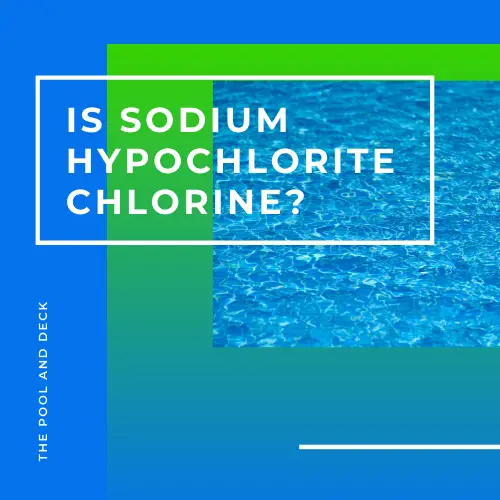Calcium Scaling in Pool: Comprehensive Guide 2025!
As an Amazon Associate, I earn from qualifying purchases.
Calcium scaling in pool is a common, but often neglected, problem that pool owners face. Calcium build up results in scaling which can be seen as unsightly white deposits on pool surfaces and equipment.

Calcium scaling in pool can also result in unsafe swimming conditions and potential health risks.
In this guide I go into the science behind calcium scaling, explore various prevention strategies, and equip you with effective removal techniques for existing buildup.
Table of Contents
What is Calcium Scaling in Pool?
Calcium scaling in pool is the buildup of calcium deposits on pool surfaces and pool equipment due to high calcium hardness levels in the water. The deposits appears as white, crusty flakes or scales on pool walls, tiles, and equipment.
Over time, calcium scaling can cause damage to pool surfaces, including etching and pitting, which may require costly repairs.
Calcium deposits on pool equipment such as filters, pumps, heaters, etc. can interfere with proper water circulation and filtration. Not only does the equipment efficiency drop the lifespan of the equipment is also shortened.
Two Types of Calcium Scaling in Pool
Calcium scaling in pool occurs when calcium carbonate or calcium silicate precipitates out of the water and adheres to surfaces, leading to unsightly stains, surface roughness and drop in the pool filtration efficiency.
When the calcium hardness level in the water exceeds its saturation point, these minerals form solid deposits on pool surfaces. Their manifestation is as under:
- Calcium Carbonate Scaling: This white, chalky buildup typically forms due to factors such as high calcium levels, alkalinity imbalances, and elevated water temperatures.
- Calcium Silicate Scaling: This harder, grayish-white deposit is often linked to using calcium-based pool chemicals, such as calcium hypochlorite shock, which can contribute to the accumulation of silicate compounds in the water.
By proactively managing calcium levels and addressing build-up, you can ensure a clean, safe, and enjoyable swimming environment.
Factors Contributing to Calcium Scaling:
In essence, the following 5 factors are the chief cause of calcium scaling in pools:
Detecting Calcium Build-Up
Early detection of calcium scaling allows for easier removal and prevents further damage. Here’s how to identify it:
- Visual Inspection: Regularly examine pool walls, tiles, and equipment for white, chalky deposits or discolored areas.
- Scratch Test: Gently scratch the deposits with a pool brush or fingernail. Crumbling deposits likely indicate calcium carbonate, while harder ones would be calcium silicate.
- Water Testing: Regularly testing your pool water for calcium hardness levels (using a pool test kit) is crucial for identifying potential scaling risks before they become a visible problem.
Recommended Chemical Test Kit
Taylor K-2005 Complete DPD 9-in-1 Test Kit
Tests for free & total chlorine, bromine, pH, total alkalinity, total hardness, and cyanuric acid (CYA) levels.
Effects of Calcium Scaling
Calcium scaling in pool is sure to cause damage to pool surfaces and equipment over time.
Aesthetics
Deposits of calcium carbonate and calcium silicate will accumulate on pool walls, tiles, and filtration systems, leading to unsightly stains and white spots.
Safety
Scaling makes pool surfaces rough and uneven, increasing the risk of injury as they can create friction and abrasions, increasing the likelihood of slips, trips, and falls. Rough calcium deposits also provide a toehold for harmful bacteria and algae to latch on and thrive.
Equipment Performance
Calcium deposits reduce pool equipment functionality. Calcium scaling will impede the smooth flow of water through the pool filtration system and will cause the pump to overwork and heat up.
Maintenance Costs
The energy cost of maintaining your pool will also go up. Calcium scaling, over time, will degrade and reduce promptly can result in costly repairs and maintenance expenses to restore damaged pool surfaces and equipment.
Preventing Calcium Scaling: A Proactive Approach
The key to a scale-free pool lies in proactive maintenance strategies:
- Maintaining Proper Water Chemistry: Test and adjust pH, alkalinity, and calcium hardness levels regularly to keep them within the recommended ranges. Consistency is key!
- Using Pool Chemicals Wisely: Utilize sequestering agents or calcium inhibitors to bind calcium ions and prevent them from forming scale. Opt for quality sanitizers and shock treatments to maintain water clarity, reducing the risk of calcium buildup from contaminants.
- Regular Pool Maintenance: Develop a routine for brushing and scrubbing surfaces to remove loose deposits. Clean filters regularly to prevent calcium build-up from accumulating within the filtration system.
- Treating Hard Water: If your pool has a hard water, consider pre-treating fill water with a metal sequestrant or installing a water softener system to reduce calcium levels before filling your pool.
Removing Existing Calcium Build-Up
For existing calcium buildup, several methods can be employed to remove it, depending on the severity:
Chemical Treatments:
Muriatic Acid (a strong acid) can be effective for mild to moderate scaling, but requires extreme caution and safety precautions due to its corrosive nature. Always wear protective gear and follow manufacturer instructions meticulously.
Note: Muriatic acid should not be used for fiberglass pools.
This method is also known as acid washing. It is typically done by completely draining the pool. However, an option of acid washing without draining also exists.
Mechanical Methods:
Pool Brushes: Use pool brushes with appropriate bristles based on your pool surface material (nylon for vinyl/fiberglass, stainless steel for concrete/plaster) to remove loose deposits.
Abrasive Pads or Sponges: For stubborn stains, abrasive pads or sponges can be used in conjunction with brushes for extra scrubbing power.
Pressure Washing: is a powerful cleaning option for extensive scaling, but use caution to avoid damaging surfaces. Always maintain a safe distance from the pool walls and adjust the pressure settings appropriately.
Sandblasting: This is a last resort for severe cases due to its aggressive nature. It should only be performed by trained professionals to prevent significant damage to your pool surfaces.
Long-Term Maintenance Tips for a Scale Free Pool
Maintaining a sparkling clean and scale-free pool requires ongoing vigilance and a commitment to proper pool care practices. Here are some tips:
- Brushing pool surfaces regularly (at least weekly) to disrupt the formation of deposits.
- Cleaning pool filters often (typically every 1-2 weeks) to prevent calcium build-up within the filtration system.
- Testing pool water chemistry (pH, alkalinity, and calcium hardness) at least once a week during peak usage periods (summer) and every other week during off-peak times.
- Consistency is key! Regular testing helps identify and address minor imbalances before they escalate into calcium scaling problems. This allows for prompt adjustments to maintain optimal water balance.
- Constantly educate yourself by reading blogs and watching YouTube videos on pool maintenance and related topics.
Thank you very much for reading the post. I do hope you found it informative and helpful.







